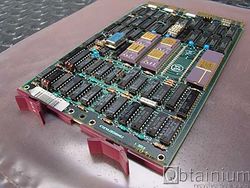Difference between revisions of "F-11 chip set"
(KEF11-B details) |
m (→See also: +) |
||
| (One intermediate revision by the same user not shown) | |||
| Line 11: | Line 11: | ||
==Chip versions== | ==Chip versions== | ||
| − | The data paths chip is the DC302, [[DEC part | + | The data paths chip is the DC302, [[DEC part number]] 21-15541-Ax, where x is a capital letter giving the revision (B is the most common, although C has been seen), which contains the registers, [[Arithmetic logic unit|ALU]], etc. The control chip is the DC303, DEC part # 23-001C7-Ax (only the A revision has been seen), which contains microcode and a small amount of miscellaneous logic. The carrier as a whole has the DEC part # 57-00000-01-A1 or 57-00000-02 (the latter with the -AC revision of the data paths chip). |
==ODT limitations== | ==ODT limitations== | ||
| Line 18: | Line 18: | ||
The later [[KDJ11 CPUs]] do not have this limitation. | The later [[KDJ11 CPUs]] do not have this limitation. | ||
| + | |||
| + | ==See also== | ||
| + | |||
| + | * [[J-11 chip set]] | ||
==External links== | ==External links== | ||
Latest revision as of 23:50, 28 March 2022

The F-11 chip set (code-named 'Fonz') was DEC's second microprocessor implementation of the PDP-11 architecture. It was used in the KDF11 CPUs. The main CPU was implemented in two chips (carried on a single DIP carrier).
Unlike the first microprocessor implementation (the LSI-11), the full F-11 chip set implemented the full PDP-11 architecture, including the optional KTF11-A memory management chip which implemented standard PDP-11 Memory Management, and the optional KEF11-A floating point chip which implemented the FP11-compatible floating point.
(The KEF11-A requires the KTF11-A, since the floating point registers are actually in the KTF11-A. The reason why is not known; although the KEF11-A is microcode, there are enough pins for both the data bus, and the microcode bus.)
There is also a double-width 6-chip carrier, the KEF11-B CIS chip, which implements the PDP-11 Commercial Instruction Set (CIS); not all KDF11 CPUs can hold this, though.
Chip versions
The data paths chip is the DC302, DEC part number 21-15541-Ax, where x is a capital letter giving the revision (B is the most common, although C has been seen), which contains the registers, ALU, etc. The control chip is the DC303, DEC part # 23-001C7-Ax (only the A revision has been seen), which contains microcode and a small amount of miscellaneous logic. The carrier as a whole has the DEC part # 57-00000-01-A1 or 57-00000-02 (the latter with the -AC revision of the data paths chip).
ODT limitations
The F-11 chip set includes microcode which provides 'front panel' functionality named 'ODT'; the ability to read and write to main memory, start the processor, etc. However, the original version of the KDF11-A only supported 18-bit addressing, and even though later versions supported 22-bit addressing, ODT in the KDF11's was always limited to 18-bit addressing: i.e. it is impossible to interact with memory above 256 Kbytes from ODT.
The later KDJ11 CPUs do not have this limitation.
See also
External links
| v • d • e PDP-11 Computers and Peripherals |
|---|
| UNIBUS PDP-11s - PDP-11/20 • PDP-11/15 • PDP-11/35 • PDP-11/40 • PDP-11/45 • PDP-11/50 • PDP-11/55 • PDP-11/70 PDP-11/05 • PDP-11/10 • PDP-11/04 • PDP-11/34 • PDP-11/60 • PDP-11/44 • PDP-11/24 • PDP-11/84 • PDP-11/94 QBUS PDP-11s - PDP-11/03 • PDP-11/23 • PDP-11/23+ • MicroPDP-11/73 • MicroPDP-11/53 • MicroPDP-11/83 • MicroPDP-11/93 QBUS CPUs: LSI-11 • LSI-11/2 • KDF11-A • KDF11-B • KDJ11-A • KDJ11-B • KDJ11-D • KDJ11-E Buses: UNIBUS • UNIBUS map • SPC • MUD • EUB • QBUS • CD interconnect • PMI Also: PDP-11 architecture • PDP-11 Extended Instruction Set • FP11 floating point • PDP-11 Memory Management |
| UNIBUS CPUs: KA11 • KC11 • KB11-A • KB11-B • KB11-C • KB11-D • KD11-A • KD11-B • KD11-D • KD11-E • KD11-EA • KD11-K • KD11-Z • KDF11-U
Co-processors: FP11-A • FP11-B • FP11-C • FP11-E • FP11-F • KE44-A • FPF11 Chips: LSI-11 • KEV11-A • KEV11-B • KEV11-C • F-11 • KEF11-A • KTF11-A • T-11 • J-11 • FPJ11 CPU options: KE11-E • KE11-F • KJ11-A • KT11-C • KT11-D • KK11-A • KK11-B • KT24 • KTJ11-B Rare CPU options: KS11 Memory Protection and Relocation option • KT11-B Paging Option • KUV11 Writeable Control Store Front panels: KY11-A • KY11-D • KY11-J • KY11-LA • KY11-LB • KY11-P More on buses: UNIBUS and QBUS termination • Bus Arbitration on the Unibus and QBUS • CTI BUS PDT-11s - PDT-11/110 • PDT-11/130 • PDT-11/150 CTI PDP-11s - PRO-325 • PRO-350 • PRO-380 Other: FIS floating point • PDP-11 Commercial Instruction Set • PDP-11 stacks • PDP-11 family differences |